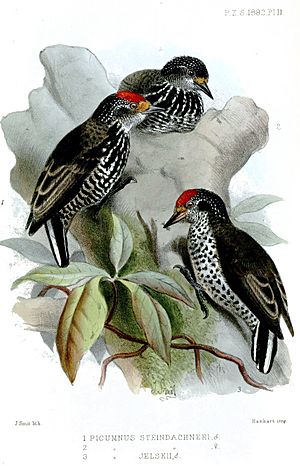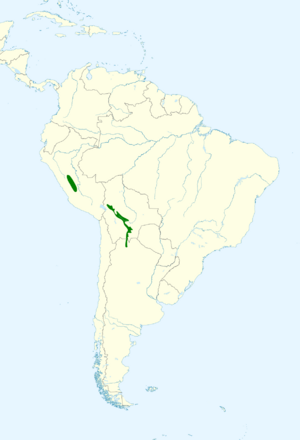Ocellated piculet facts for kids
Quick facts for kids Ocellated piculet |
|
|---|---|
 |
|
| Male and female speckle-chested piculet (above), male ocellated piculet below | |
| Conservation status | |
| Scientific classification | |
| Genus: |
Picumnus
|
| Species: |
dorbignyanus
|
 |
|
| Synonyms | |
|
Picumnus d’Orbignyanus |
|
The ocellated piculet (Picumnus dorbignyanus) is a small, interesting bird that belongs to the woodpecker family. It is part of the Picumninae group. You can find this bird mainly in Bolivia and Peru, and possibly even in parts of Argentina.
Contents
About Its Name
This little bird was first described in 1845 by a French bird expert named Frédéric de Lafresnaye. He named it Picumnus d’Orbignyanus to honor another French naturalist, Alcide d'Orbigny. Sometimes, people have misspelled its name.
The ocellated piculet has two main types, called subspecies: P. d. dorbignyanus and P. d. jelskii. These types are very similar but have small differences. Sometimes, experts have wondered if these types should be separate species or even part of another bird called the white-barred piculet. The ocellated piculet is closely related to the white-barred piculet and the ochre-collared piculet. These birds can sometimes have babies together where their homes overlap.
What It Looks Like
The ocellated piculet is a small bird, about 9 to 10 cm (3.5 to 3.9 in) long. That's about the length of your hand! It weighs between 7 to 11 g (0.25 to 0.39 oz), which is lighter than a few paper clips.
Male and Female Birds
Adult male ocellated piculets have a black cap on their head. The feathers on their forehead have cool red tips, and the rest of the cap has tiny white spots. Their face is mostly brownish-buff with faint dark bars and a white stripe behind their eye. Their upper body is dull brownish, sometimes with faint whitish bars. Their flight feathers are dark brown with light edges and tips. Their tail is dark brown, with white on the inner feathers and white stripes on the outer ones.
Their chin and throat are white with a buff tint and dark edges. Their chest and sides are white with narrow black lines, and their belly is a buffy white color. Their eyes are brown, with a gray ring around them. Their legs are gray. The top part of their beak is black with a blue-gray base, and the bottom part is blue-gray with a black tip.
Female ocellated piculets look almost exactly like the males, but they do not have the red tips on their forehead feathers. Young birds are usually duller and darker than adults. They have a sooty-colored crown and less clear markings on their body.
Differences in Subspecies
The P. d. jelskii subspecies looks very much like the main type. However, its chest feathers have wider black streaks, and its forehead feathers have broader red tips.
Where It Lives and Its Home
The P. d. jelskii subspecies of the ocellated piculet lives in central Peru. The main subspecies, P. d. dorbignyanus, is found in western Bolivia and possibly in the very northwestern part of Argentina. Different bird groups have slightly different ideas about whether it lives in Argentina.
This piculet makes its home inside and at the edges of humid montane forests, which are forests found in mountains. It also lives in older secondary forests, which are forests that have grown back after being cut down. It especially likes bushy areas with vines, climbing plants, and epiphytes (plants that grow on other plants). In Peru, it lives at heights between 800 and 2,400 m (2,600 and 7,900 ft) above sea level. In Bolivia, it can be found even higher, from 900 to 3,300 m (3,000 to 10,800 ft).
How It Behaves
Movement
The ocellated piculet usually stays in one area. However, it might move to lower places during the winter months.
Feeding Habits
This bird looks for food along thin branches and vines. It usually forages alone or in pairs. Sometimes, it joins a mixed species foraging flock, which is a group of different bird species looking for food together. We don't know everything about what it eats, but we do know it includes insects in its diet.
Reproduction
The ocellated piculet builds its nests in holes. Beyond that, not much is known about how it raises its young or its breeding habits.
Vocalization
The song of the ocellated piculet is a "high-pitched, fast, falling trill." It sounds like tree'e'e'e'e'e'e.
Its Conservation Status
The IUCN (International Union for Conservation of Nature) has decided that the ocellated piculet is a species of "Least Concern." This means it is not currently in danger of disappearing. It lives in a fairly large area, and even though we don't know its exact population size, it is believed to be stable. There are no immediate threats that have been found for this bird. It is generally thought to be uncommon, but in some places, you might see many of them. Human activities don't have a big direct impact on the ocellated piculet, except for local habitat destruction.


